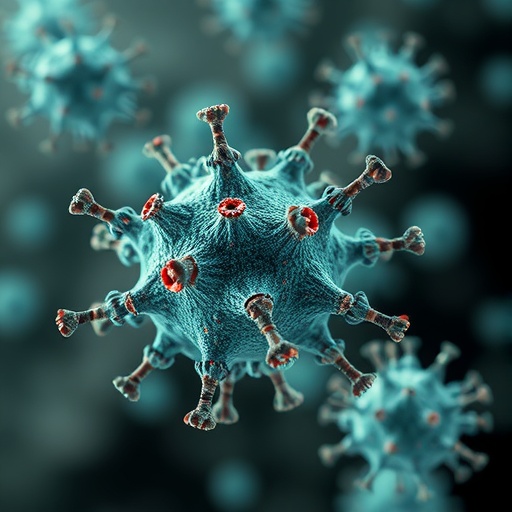In recent years, the fight against flaviviral infections has taken on a new level of urgency within the scientific community. Flaviviruses, including Dengue, Zika, and West Nile viruses, pose significant public health challenges worldwide. As these viruses spread beyond traditional boundaries, the need for effective therapeutic interventions has never been more pressing. A promising approach that emerges from recent research is the development of N-Heterocyclic protease inhibitors, which show potential as targeted treatments against these viral pathogens.
The recent study by Nath, Akhtar, and Pradhan presents a comprehensive review of the structure-activity relationships (SAR) related to these novel inhibitors. The authors delve into the intricate chemistry behind N-Heterocycles, which are known for their diverse applications in medicinal chemistry. The review meticulously details how modifications in the chemical structure of these compounds can significantly influence their inhibitory activity against the viral proteases that are critical for flavivirus replication and maturation.
Proteases are enzymes that play pivotal roles in the life cycle of flaviviruses. These enzymes are essential for processing polyproteins into functional proteins, a process necessary for viral replication. As such, inhibiting protease activity can dramatically reduce the viral load in infected hosts. The researchers highlight the importance of understanding the SAR of N-Heterocyclic compounds to optimize their design and improve their efficacy as protease inhibitors.
One aspect that stands out in this study is the exploration of diverse N-Heterocyclic frameworks. The researchers categorize various classes of N-Heterocyclic compounds, including imidazoles, pyrazoles, and quinolines, each possessing distinct chemical properties that impact their biological activity. Through a systematic examination of these classes, the authors provide insights into how structural variations can lead to enhanced binding affinity and selectivity toward flavivirus proteases.
Ultimately, the goal of designing these inhibitors is to create a therapeutic option that is not only effective against the viruses but also possesses a favorable safety profile. The article goes on to discuss recent advancements in synthetic methods that have allowed researchers to generate complex N-Heterocyclic molecules with varied functional groups. These synthetic advancements are crucial in providing a library of candidates for pharmacological evaluation.
Alongside discussions of synthetic methodologies, the review incorporates a strategic analysis of the existing literature on flaviviral protease inhibitors. By synthesizing previous findings, the authors provide a clear picture of the current landscape of research in this area. They emphasize the importance of collaborative research and interdisciplinary approaches in developing these compounds, underscoring how chemistry, biology, and pharmacology can converge to address this global health challenge.
Moreover, the authors address the role of computational methods in drug design, particularly molecular docking studies that predict the binding interactions between N-Heterocycles and their target proteases. Utilizing advanced computational modeling allows researchers to simulate how these chemical entities interact at the molecular level, which can lead to more efficient refinements in compound design and selection.
The review also touches on the significance of in vitro and in vivo studies in validating the efficacy of these inhibitors. While laboratory results can showcase their potential, real-world effectiveness depends on comprehensive biological evaluations. As part of this discussion, the authors cite recent advances in preclinical trials that highlight promising results in terms of antiviral activity, safety profiles, and pharmacokinetic properties.
As researchers continue to refine the chemical architecture of N-Heterocyclic protease inhibitors, the hope is to expedite the translation of these findings into clinical applications. This shift from conceptual research to therapeutic deployment presents challenges, including regulatory hurdles and the need for extensive safety testing, yet the benefits could be profound.
The global rise of flaviviral diseases calls for a multifaceted response that integrates vaccine development, public health initiatives, and therapeutic advancements. N-Heterocyclic compounds represent one promising avenue in this fight, and the insights gleaned from Nath and colleagues’ review could catalyze further discoveries.
The need for novel antiviral agents is underscored by the continuous mutation of viruses, which can render existing treatments ineffective. Continuous research into the antiviral potential of N-Heterocycles not only addresses immediate health concerns but also prepares the scientific community for future challenges posed by emerging pathogenic threats.
In conclusion, the research outlined by Nath and his collaborators marks a significant contribution to the ongoing exploration of N-Heterocyclic protease inhibitors. Their detailed examination of structure-activity relationships coupled with synthetic methodologies illustrates an optimistic path toward developing effective therapeutics against flaviviral infections. While challenges remain, the commitment of the scientific community to innovate within this space offers hope for new treatments that can help mitigate the burden of flaviviral diseases globally.
As scientists continue to unravel the complex interplay between chemical design and viral pathology, the potential for creating a new class of antiviral drugs grows ever closer. The significance of this research cannot be overstated—it may very well be a keystone in the long-term strategy to combat flavivirus outbreaks worldwide.
Subject of Research: Development of N-Heterocyclic protease inhibitors for flaviviral infections.
Article Title: Design and development of N-Heterocyclic protease inhibitors for flaviviral infections: a synthetic and SAR-based review.
Article References:
Nath, R., Akhtar, M.J., Pradhan, S.S. et al. Design and development of N-Heterocyclic protease inhibitors for flaviviral infections: a synthetic and SAR-based review.
Mol Divers (2025). https://doi.org/10.1007/s11030-025-11374-5
Image Credits: AI Generated
DOI: 10.1007/s11030-025-11374-5
Keywords: N-Heterocycles, protease inhibitors, flavivirus, structure-activity relationship, antiviral therapy.
Tags: antiviral drug developmentDengue virus treatment strategiesFlavivirus protease inhibitorsInhibiting viral replication mechanismsmedicinal chemistry innovationsN-Heterocyclic compoundsPublic health challenges of flaviviral infectionsStructure-activity relationshipsTargeted therapies for flavivirusesViral protease enzymologyWest Nile virus therapeutic approachesZika virus antiviral research





